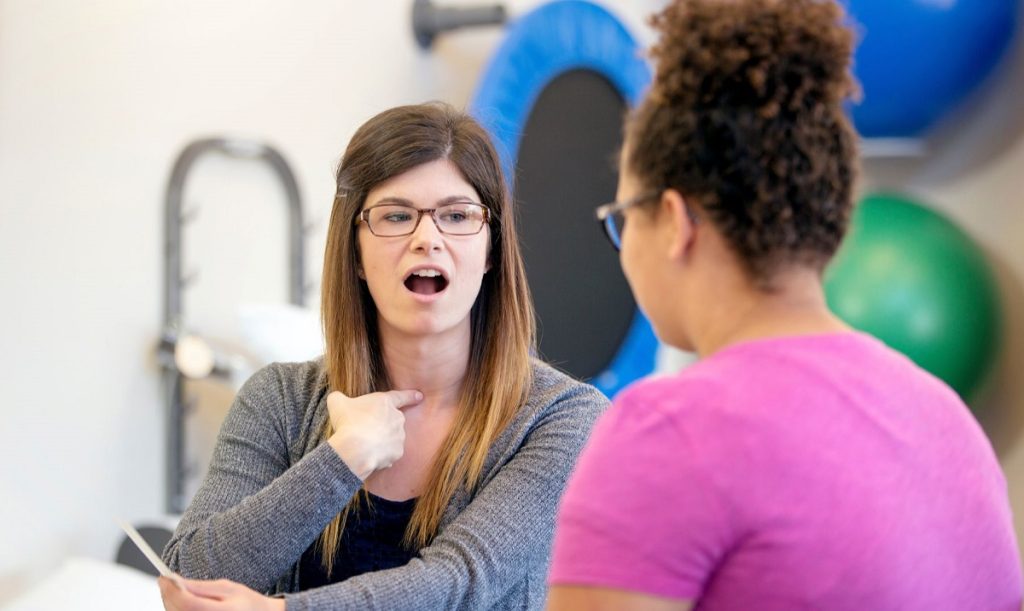Speech exercises are a type of vocal training useful for improving your speaking skill and include articulation, pronunciation, and projection. Those who are fearful of speaking in public use them to reduce anxiety and improve their confidence in public speaking with speech exercises.
Your voice is a remarkable tool capable of captivating audiences, conveying emotions, and leaving a lasting impact. Whether you’re a professional speaker, an aspiring actor, or simply someone seeking to enhance your communication skills, vocal training through speech exercises can unlock the true potential of your voice.
These exercises, designed to improve diction, projection, tone, and clarity, go beyond mere vocal warm-ups to develop a commanding and persuasive presence.
This article delves into the world of speech exercises, exploring their benefits, techniques, and practical applications, empowering you to harness the power of your voice like never before.
What Is A Speech Exercise?
A speech exercise is a structured practice to improve various aspects of vocal performance and communication. It involves targeted activities focusing on developing vocal clarity, language skills, articulation, breath control, projection, and overall vocal health.
Vocal Warm-Ups
These exercises include vocal warm-ups, tongue twisters, breathing techniques, pitch and intonation exercises, tongue and jaw exercises, and resonance exercises.
Regularly engaging in speech exercises enhances vocal skills, increases range and flexibility, and improves overall speech delivery and communication effectiveness.
Engaging in diction exercises, such as practicing the phrase “thick thistle sticks,” can enhance clarity and enunciation. These exercises, along with oral motor activities, assist individuals in developing proper muscle control for speech production.
Reading Aloud
Reading aloud, participating in a podcast, or receiving guidance from a speech-language pathologist (SLP) are effective ways to refine pronunciation, expand vocabulary, and employ body language to express ideas effectively.
Whether aiding those recovering from a brain injury or addressing speech difficulties, vocal exercises are valuable tools in speech-language pathology.

Why Is It Important To Exercise Your Speech?
Exercising your speech is important for several reasons.
It improves your articulation and clarity, ensuring that others easily understand your message. Speech exercises enhance vocal projection, allowing you to command attention and convey your ideas with confidence and authority.
These voice exercises develop breath control, enabling you to sustain longer phrases without running out of breath. Regular speech exercises promote vocal health, preventing strain, hoarseness, and vocal fatigue, ensuring the longevity of your voice for effective communication in various settings.
How Can You Improve Your Speech?
Improving your speech involves a combination of practice, awareness, and targeted exercises. Here are four key ways to enhance your address:
- Focus on enunciating each word clearly, paying attention to consonant sounds and vowel pronunciation. Practice tongue twisters and exercises that emphasize diction to improve articulation.
- Develop the ability to project your voice by practicing diaphragmatic breathing and engaging your core muscles. Experiment with volume and pitch control to effectively reach different audiences and create impact.
- Work on varying your tone and inflection to convey different emotions and add depth to your speech. Practice speaking with intention and emphasize keywords or phrases to enhance the overall delivery.
- Actively listen to your own speech and seek constructive feedback from others. Pay attention to areas that need improvement, such as pacing, filler words, or vocal habits, and work on refining those aspects through focused practice.
Remember, consistent practice and self-reflection are crucial for continuous improvement in speech.

What Exercises Help With Speech?
Various exercises assist greatly in improving speech. Here are four practices that are particularly beneficial:
- Tongue twisters are an excellent way to enhance articulation and clarity. Practice phrases that challenge your tongue and speech muscles, such as “She sells seashells by the seashore” or “Peter Piper picked a peck of pickled peppers. A peck of pickled peppers Peter Piper picked. If Peter Piper picked a peck of pickled peppers, Where’s the peck of pickled peppers Peter Piper picked?”
- Focus on practicing individual vowel and consonant sounds to refine your pronunciation. Repeat sounds like “ah,” “ee,” “oo,” or consonant combinations like “th,” “sh,” and “ch” to improve precision and control over your speech.
- Tongue trills involve fluttering your tongue against the roof of your mouth while making a continuous “rrrr” sound. This exercise helps relax and warm up the muscles involved in speech production, promoting better vocal control and flexibility.
- The “raspberry” exercise involves making a vibrating “brrr” or “prrr” sound with your lips, similar to a buzzing sound. It helps loosen up your facial muscles and increases oral resonance, improving overall vocal quality and projection.

How Do You Exercise To Speak More Clearly?
To exercise and speak more clearly, consider incorporating the following techniques into your practice routine:
- Engage in exercises that specifically target articulation to improve clarity in your speech. Practice pronouncing words and phrases with precise diction, emphasizing each syllable and consonant. Tongue twisters, such as “Unique New York” or “Red leather, yellow leather,” is particularly helpful in refining articulation.
- Slow down your speech and focus on each word, allowing yourself time to enunciate clearly. Refrain from rushing through sentences or mumbling words. By speaking at a measured pace, you allow yourself to articulate words accurately and express your thoughts more clearly.
- Develop proper breath control techniques to support your speech. Practice diaphragmatic breathing, inhaling deeply, filling your abdomen with air, and releasing the air slowly as you speak. This helps provide a steady airflow for clearer and more controlled speech.
- Pay attention to specific sounds or words you find challenging and practice them regularly. Listen to native speakers or pronunciation guides to learn the correct pronunciation of unfamiliar words. Practice those words repeatedly, focusing on the accurate production of each sound.
- Warm up your vocal apparatus before speaking to enhance clarity. Perform exercises like gentle humming, lip trills, or tongue stretches to relax and awaken the muscles involved in speech production. These warm-ups help you achieve better vocal control and clarity.
Can Tongue Exercises Improve Speech?
Tongue exercises significantly improve speech by enhancing articulation, clarity, and overall oral muscle coordination. The tongue plays a crucial role in forming various sounds and consonant articulation, making it essential to strengthen and control its movements. Here are some ways tongue exercises are beneficial:
- These exercises help strengthen the tongue muscles, making them more agile and precise. Strengthened tongue muscles produce clearer speech sounds and reduce issues like mumbling or unclear pronunciation.
- By practicing specific tongue movements and positions, you improve your ability to articulate various sounds and pronounce words accurately. Tongue exercises target specific speech difficulties, such as difficulties with certain consonant sounds or tongue placement for particular vowels. Practicing in front of a mirror can pinpoint specific tongue positions.
- Tongue exercises improve the coordination between the tongue and other speech organs, such as the lips, teeth, and palate. This coordination is crucial for producing fluent and intelligible speech. Exercises like tongue twisters or tongue movements in different directions help enhance coordination skills.
- Regular tongue exercises increase the flexibility of the tongue, allowing it to move more freely and precisely. This flexibility is essential for adapting to different speech sounds and producing them accurately.
It’s important to note that tongue exercises alone may not address all speech issues. Professional guidance from a speech-language pathologist or speech therapist provides tailored activities for your individual speech goals.
Speech therapy exercises help children overcome challenges such as apraxia of speech or dysarthria, improving their ability to articulate words and strengthen their vocal cords. Vocal exercises play a crucial role in a child’s speech development.

How Do You Train Your Speech Muscles?
Training your speech muscles involves exercises and techniques that focus on developing the muscles involved in speech production. Here are four ways to effectively train your speech muscles:
- Perform exercises that target the tongue and jaw muscles. For example, practice moving your tongue from side to side, up and down, or in circular motions. Open and close your jaw slowly and deliberately. These exercises help improve muscle control, flexibility, and coordination.
- Engage in exercises that target the lips and facial muscles. Practice smiling widely, puckering your lips, or exaggerating lip movements while pronouncing different sounds. These exercises help strengthen the muscles responsible for lip movements, facial expressions, and overall facial muscle control.
- Develop strong breath control by practicing diaphragmatic breathing. This technique involves breathing deeply into your abdomen, allowing the diaphragm to engage fully. Strengthening your breath support helps maintain consistent airflow during speech, resulting in clearer and more controlled vocalization.
- Warm up your speech muscles before engaging in extended speaking or vocal activities. Perform gentle humming, lip trills, or tongue trills to relax the vocal apparatus. These warm-ups help improve muscle flexibility, reduce tension, and prepare the speech muscles for optimal performance.
Which Exercises Help With Stuttering?
There are several speech exercises and techniques that help individuals who stutter. Here are four activities commonly used in stuttering therapy:
- Practice speaking slowly and deliberately. Focus on maintaining a relaxed pace and emphasizing each word. By slowing down your speech rate, you reduce the tendency to rush or feel hurried, which contributes to stuttering.
- Use the “easy onset” technique to initiate speech. Instead of starting a word or phrase with forceful or abrupt sounds, begin gently and gradually increase the airflow and tension. This technique reduces anxiety and allows for smoother speech production.
- Practice prolonging sounds or syllables in words. Start by choosing a word and intentionally stretch out the initial sound. For example, instead of saying “t-t-today,” stretch the “t” sound gently and smoothly. Prolonged speech promotes relaxation and increases fluency.
- Incorporate breathing exercises to enhance control and reduce tension. Diaphragmatic breathing, where you breathe deeply into your abdomen, regulates airflow and provides a calm foundation for speech. Focus on relaxed exhalation before speaking and maintain steady breathing throughout.

